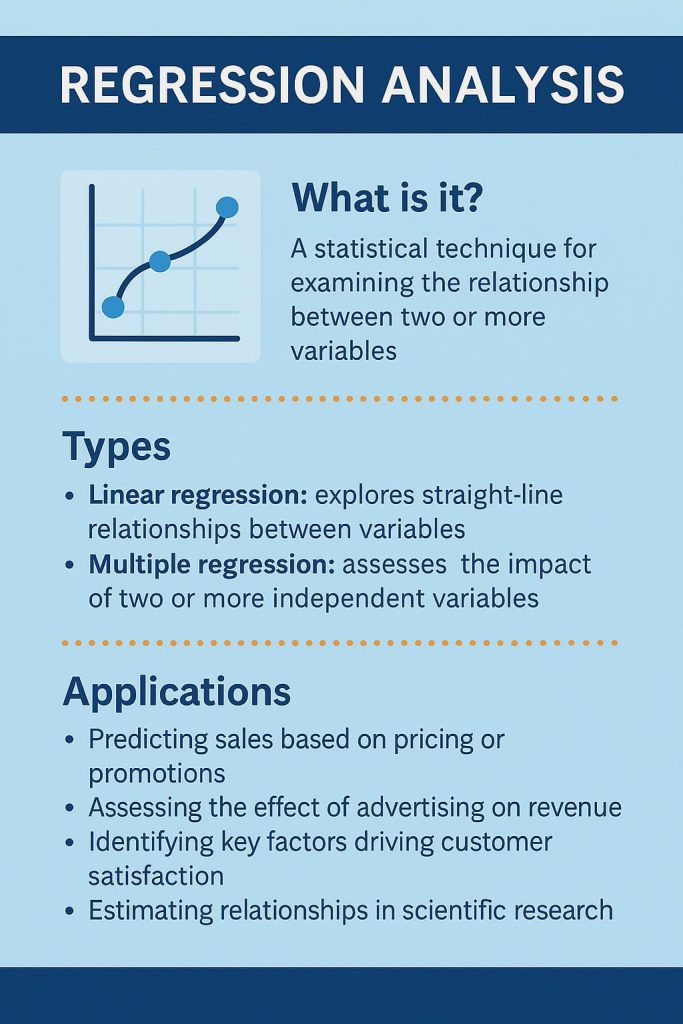Regression Analysis in Research

Regression analysis is experiencing a renaissance that’s fundamentally transforming research capabilities across every field.
That mountain of data sitting on your hard drive is utterly useless… At least until you extract the gold hidden inside it.
There are brilliant researchers with fancy degrees drowning in spreadsheets while missing the insights that could transform their entire field. The difference between them and the rare few who actually drive breakthroughs? Not IQ. Not funding. Not luck.
It’s regression analysis in research!
Table of Contents
✅ Listen to this PODCAST EPISODE here:
What Exactly Is Regression Analysis?
Regression analysis in research is about answering the single most important question in any investigation: “What actually causes what?”
It’s a statistical detective work that separates genuine relationships from illusions. It’s reverse-engineering reality with mathematics.
Unlike correlation (that nearly useless metric that merely says “these things move together somehow”), regression analysis in research quantifies exact relationships. It doesn’t just tell you that exercise and health connect – it tells you precisely how much health improvement you get from each additional minute of exercise, while simultaneously accounting for diet, sleep, genetics, and any other factor you can measure.
The Purpose Behind the Math
Regression analysis in research serves two fundamental purposes that have revolutionized nearly every field of human knowledge:

Prediction and forecasting: By quantifying precisely how variables interact, regression lets you see the future. Not with crystal balls or tarot cards, but with mathematical projections based on established relationships. From forecasting which patients will deteriorate to predicting which customers will leave, regression converts historical patterns into forward-looking intelligence.
Inferring causal relationships: While the tired mantra “correlation doesn’t equal causation” gets repeated ad nauseum, properly designed regression analysis in research takes us much closer to understanding causality than most methods.
… And that distinction literally saves lives, companies, and careers.
Why Regression Analysis Matters Across Fields

在 卫生保健, regression models don’t just organize data – they save lives. It identifyes which factors actually predict patient deterioration (versus factors that merely correlate with it), medical teams intervene with the right patients at the right time.
Social scientists tackle impossibly complex human phenomena with regression tools that untangle the genuine influences from the red herrings. Educational outcomes, crime patterns, voting behavior – all yield their secrets to properly constructed regression models.
Business teams that master regression analysis in research operate with almost unfair advantages over competitors. While others rely on executive intuition and market “feel,” regression-driven organizations precisely quantify customer drivers, operational efficiencies, and market movements before others even realize what’s happening.
Types of Regression Analysis
Each variant exists because reality rarely fits neatly into simplistic models.
Linear Regression: The Foundation
What makes linear regression analysis in research so valuable isn’t its mathematical elegance but its interpretability.
Strip away the intimidating equations, and linear regression is just quantifying how much one thing changes when another thing changes. It’s the simplest form of regression analysis in research, expressed as:
Y = β₀ + β₁X + ε
Where:
- Y is what you’re trying to predict or understand
- X is what you think influences Y
- β₀ is the starting point (what Y equals when X is zero)
- β₁ is the critical number – how much Y changes when X increases by one unit
- ε represents everything else affecting Y that you haven’t measured
Most people get caught up in the mechanics of calculating these values (usually handled by software anyway) while missing the profound insight linear regression provides: quantifying exactly how much one variable influences another.
Multiple Linear Regression: Handling Complexity
Reality is messy. Outcomes rarely have just one cause. Multiple regression acknowledges this complexity:
Y = β₀ + β₁X₁ + β₂X₂ + … + βₚXₚ + ε
This isn’t just linear regression with more stuff thrown in. It’s a fundamentally different tool that reveals how variables work together – sometimes reinforcing each other, sometimes canceling each other out, sometimes interacting in unexpected ways.
The revolutionary power of this approach to regression analysis in research comes from its ability to isolate effects. Want to know how education affects income while controlling for experience, location, industry, gender, and family background? Multiple regression delivers precisely that insight.
Nonlinear Regression: Beyond Straight Lines
Almost nothing in nature or human behavior follows truly linear patterns.
Nonlinear regression analysis in research acknowledges this reality by allowing for curved relationships:
- Polynomial regression captures relationships that accelerate or decelerate (adding X², X³ terms)
- Exponential regression models explosive growth or decay patterns
- Logarithmic regression handles diminishing returns scenarios
Stepwise Regression: Automated Selection
Sometimes you face dozens or even hundreds of potential predictors with limited theoretical guidance on which matter most. Enter stepwise regression – the controversial but pragmatic approach to variable selection in regression analysis in research.
It works by algorithmically adding or removing variables based on statistical criteria:
- Forward selection: Starts empty and adds variables that improve the model
- Backward elimination: Starts with everything and removes what doesn’t contribute
- Bidirectional: Combines both approaches, constantly reassessing each variable
Statistical purists hate stepwise methods. They’ll lecture you about inflated significance and data-driven selection. Sometimes they’re right. But when you’re facing 200 potential variables and need a starting point, these approaches offer practical value that theoretical perfectionism doesn’t.
Logistic Regression: Analyzing Binary Outcomes
Some of the most important questions in research are binary: Will this patient survive? Will this customer buy? Will this student graduate?
Logistic regression transforms regression analysis in research for these yes/no scenarios. Instead of predicting a value directly, it estimates the probability of an outcome occurring.
The mathematical details involve log-odds and S-shaped curves, but the practical impact is revolutionary: the ability to identify which factors actually drive binary outcomes and by exactly how much.
Medical researchers use logistic regression to develop risk scores that predict complications with stunning accuracy. Marketers employ it to identify which customer characteristics actually drive conversion. Financial institutions rely on it to distinguish borrowers likely to default from those who will repay.
Quantile Regression: Beyond the Mean
Standard regression answers one question: “What happens on average?” But often, the extremes matter more than the average.
Quantile regression shifts the focus of regression analysis in research from the middle to any percentile of interest – the top performers, the worst outcomes, or anywhere in between.
This is a fundamentally different analytical lens that reveals how relationships change across distributions. Factors that drive typical outcomes often differ dramatically from those driving exceptional results or catastrophic failures.
Bayesian Regression: Incorporating Prior Knowledge
Most statistical approaches pretend we know nothing until the data speaks. Bayesian regression acknowledges a simple truth: we usually know something before we start.
This approach to regression analysis in research mathematically combines prior knowledge with new data, weighing each according to its reliability. The result isn’t just more accurate – it’s more aligned with how human knowledge actually accumulates.
The philosophical distinctions between Bayesian and traditional frequentist approaches run deep, but the practical impacts are straightforward: more stable estimates with small samples, more intuitive uncertainty quantification, and the ability to incorporate external knowledge that traditional methods simply discard.
Components of a Regression Model

Understanding the building blocks of regression analysis in research provides clarity on both its mechanics and interpretation:
Dependent Variable: The Outcome of Interest
The dependent variable (also called the response variable or outcome) is what your regression model aims to explain or predict. It’s the “Y” in your equation—the variable that depends on other factors.
In medical research, dependent variables might include patient survival times, treatment response rates, or quality-of-life measures. Economic research might focus on GDP growth, inflation rates, or consumer spending as dependent variables.
Independent Variables: The Explanatory Factors
Independent variables (also called predictors, explanatory variables, or covariates) are the factors you believe influence your dependent variable. They’re the “X” values in your regression equation.
These variables can represent virtually anything: demographic characteristics, treatment conditions, economic indicators, environmental factors, or any other variables relevant to your research question.
Effective regression analysis in research requires careful selection of independent variables based on theoretical understanding, prior research, and practical considerations like measurement feasibility.
Error Terms: Accounting for Uncertainty
Error terms (often denoted as ε or residuals) represent the difference between observed values and those predicted by your model. They capture:
- Measurement error in variables
- Unobserved factors influencing the dependent variable
- Random variation inherent in most natural processes
Analysis of these error terms forms a critical component of regression diagnostics, helping researchers assess model assumptions and identify potential improvements.
Parameters: Quantifying Relationships
Parameters (typically denoted as β) are the coefficients estimated during regression analysis in research. They quantify the strength and direction of relationships between independent and dependent variables.
In linear regression, each coefficient represents the expected change in the dependent variable for a one-unit increase in the corresponding independent variable, holding all other variables constant.
Parameter estimation methods vary across regression types but typically aim to minimize some measure of prediction error while maintaining desirable statistical properties like unbiasedness and efficiency.
Assumptions in Regression Analysis
The validity of regression analysis in research depends on several core assumptions. Understanding these assumptions is critical for proper model interpretation and application:
Representative Sample
Regression models assume that your data represents the population of interest. Sampling bias can severely distort findings and limit generalizability.
For example, a regression analysis of income factors based solely on college graduates cannot be generalized to the entire population. Similarly, medical studies using convenience samples from single hospitals may not represent broader patient populations.
Measurement Quality
Regression assumes independent variables are measured without error—an assumption almost always violated in practice to some degree.
Significant measurement error in predictors can bias coefficient estimates, typically toward zero (attenuation bias). This means regression analysis in research might underestimate true relationships when variables are measured imprecisely.
While perfect measurement rarely exists, researchers can mitigate this issue through improved measurement techniques, multiple indicators, or statistical methods designed to account for measurement error.
Homoscedasticity
Homoscedasticity assumes that error terms maintain constant variance across all levels of independent variables. When violated (heteroscedasticity), standard errors become biased, affecting hypothesis tests and confidence intervals.
For instance, in financial regression analysis, volatility often increases with asset value, violating this assumption. Similarly, prediction errors for extreme values often exceed those for average observations.
Robust standard errors, weighted least squares, or transformation of variables can address heteroscedasticity when present in regression analysis in research.
Independence of Residuals
Regression assumes that error terms are uncorrelated with each other. Violation occurs commonly in time series data (serial correlation) or clustered data (where observations within groups are related).
When this assumption fails, standard errors become unreliable, typically underestimating the true uncertainty in parameter estimates. This leads to excessive confidence in results that may not be justified.
Specialized forms of regression analysis in research, such as time series regression or mixed-effects models, can accommodate various forms of dependency among observations.
Applications of Regression Analysis

The versatility of regression analysis in research has led to its application across countless domains. Here are some prominent examples:
医疗保健研究
Regression analysis in research has transformed modern medicine by:
- Identifying risk factors for diseases through multiple regression, controlling for confounding variables
- Predicting patient outcomes based on treatment variables and patient characteristics
- Evaluating treatment efficacy in randomized clinical trials while adjusting for baseline differences
- Analyzing survival data through specialized regression techniques like Cox proportional hazards models
Economic Analysis
Economists rely heavily on regression analysis in research to:
- Forecast economic indicators like GDP growth, inflation, and unemployment
- Estimate price elasticities and other market response parameters
- Evaluate policy interventions through techniques like difference-in-differences regression
- Model complex economic systems with simultaneous equation regression models
The influential work of economists like Angrist and Krueger has used regression techniques to answer questions about education’s impact on earnings, revolutionizing how we understand human capital development.
客户洞察
Businesses apply regression analysis in research to understand consumer behavior:
- Identifying drivers of customer satisfaction through multiple regression
- Predicting customer lifetime value based on demographic and behavioral variables
- Analyzing factors influencing purchase decisions and brand loyalty
- Optimizing pricing strategies through regression-based price sensitivity analysis
Social Sciences
Social scientists employ regression analysis in research to untangle complex social phenomena:
- Analyzing factors influencing educational outcomes while controlling for socioeconomic variables
- Studying determinants of crime rates across different communities
- Examining voting patterns and political behavior
- Investigating relationships between policy interventions and social indicators
Advantages of Regression Analysis
The widespread adoption of regression analysis in research stems from several key advantages:
Flexibility Across Data Types
Few statistical methods match the flexibility of regression analysis in research. The regression framework accommodates:
- Continuous, categorical, and count-based dependent variables
- Linear and nonlinear relationships
- Cross-sectional, time series, and panel data structures
- Observational and experimental research designs
Predictive Power
Regression models excel at predicting outcomes based on observed relationships:
- Out-of-sample validation techniques can assess predictive accuracy
- Confidence intervals quantify prediction uncertainty
- Models can be updated as new data becomes available
- Advanced techniques like regularization can enhance predictive performance
Quantification of Relationships
Perhaps the greatest strength of regression analysis in research is its ability to quantify relationships with mathematical precision:
- Coefficient values provide clear estimates of effect sizes
- Standardized coefficients allow comparison across variables measured in different units
- Confidence intervals quantify uncertainty in relationship estimates
- Statistical tests evaluate whether observed relationships are likely due to chance
Limitations of Regression Analysis
Despite its power, regression analysis in research comes with important limitations researchers must consider:
Assumption Violations
The validity of regression results depends on meeting assumptions that are often violated in real-world data:
- Non-normal residuals can affect hypothesis tests in smaller samples
- Heteroscedasticity distorts standard errors and confidence intervals
- Multicollinearity among predictors creates unstable coefficient estimates
- Omitted variable bias occurs when important predictors are excluded
Overfitting Risks
Complex regression models with many predictors risk overfitting—capturing random noise in the data rather than underlying relationships:
- Models may show excellent fit to training data but poor performance with new data
- Additional predictors almost always improve in-sample fit, even when irrelevant
- Researchers may engage in “p-hacking” by trying numerous model specifications
Causal Inference Limitations
While regression can identify associations, establishing causality requires additional considerations:
- Regression alone cannot definitively establish causal relationships
- Endogeneity problems arise when independent variables correlate with error terms
- Reverse causality remains possible in many observational studies
- Unmeasured confounding variables may create spurious relationships
Emerging Trends in Regression Analysis
The field of regression analysis continues to evolve with several exciting developments:
Robust Regression Methods
Outliers and violations of assumptions can heavily influence traditional regression. Robust regression methods address these limitations:
- M-estimators downweight the influence of outliers
- Quantile regression estimates relationships at different points in the distribution
- Heteroscedasticity-consistent standard errors correct for non-constant variance
Machine Learning Integration
The boundaries between traditional regression and machine learning continue to blur:
- Regularization methods like LASSO and ridge regression improve prediction and variable selection
- Ensemble methods combine multiple regression models for enhanced performance
- Tree-based methods like random forests handle complex nonlinear relationships
- Neural networks capture intricate patterns beyond traditional regression capabilities
Geographic Weighted Regression
Many relationships vary across space, violating the assumption of constant parameters:
- Geographic weighted regression estimates different parameters for different locations
- Spatial lag models account for dependency among nearby observations
- Spatial error models handle correlated errors across geographic units

Key Insights: What You Need to Remember About Regression Analysis
✅ It transforms subjective hunches into quantifiable relationships with mathematical precision
✅ The technique spans from dead-simple linear models to sophisticated machine-learning hybrids
✅ When properly executed, regression analysis in research provides predictive power that borders on prophetic
✅ The most valuable insights often come not from the coefficients themselves but from the patterns in what doesn’t fit your model
✅ No other statistical approach offers this combination of interpretability, flexibility, and predictive capability
✅ Most researchers dramatically underutilize regression by treating it as a mechanical procedure rather than an investigative art
✅ The gap between those who merely run regression and those who truly understand it represents one of the widest competitive moats in modern research
Why Organizations Choose SIS International for Regression Analysis
- METHODOLOGICAL MASTERY: Our team doesn’t just run regression models – they understand the underlying mathematics and assumptions that determine validity.
- INTERDISCIPLINARY EXPERTISE: While most firms approach regression from a purely statistical perspective, SIS combines statistical rigor with domain knowledge across healthcare, finance, consumer behavior, and social sciences.
- CUSTOM MODEL DEVELOPMENT: Rather than forcing your research questions into standardized regression templates, we develop bespoke models specifically tailored to your unique research context, data structure, and business objectives.
- INTERPRETATIONAL CLARITY: Our deliverables transform complex regression outputs into clear, actionable insights. We translate coefficient values, interaction terms, and model diagnostics into plain-language implications that drive decision-making.
- ASSUMPTION VERIFICATION: Unlike firms that gloss over the critical assumptions underlying regression analysis in research, we rigorously test each assumption and implement appropriate corrections when violations occur, ensuring your conclusions rest on solid statistical ground.
- INTEGRATED QUALITATIVE CONTEXT: We supplement regression findings with qualitative context that explains not just what relationships exist, but why they exist – creating a comprehensive understanding that purely quantitative approaches cannot achieve.
- IMPLEMENTATION GUIDANCE: Beyond delivering statistical results, we provide concrete recommendations for how regression findings should influence strategy, resource allocation, and operational decisions.
经常问的问题
What’s the difference between correlation and regression analysis?
While correlation measures the strength and direction of association between two variables, regression analysis in research quantifies the relationship mathematically, allowing for prediction and understanding how changes in independent variables affect the dependent variable. Regression also accommodates multiple predictors simultaneously.
How large should my sample size be for reliable regression analysis?
Sample size requirements depend on factors including the number of predictors, expected effect sizes, and desired precision. A common rule of thumb suggests at least 10-20 observations per predictor variable, though complex relationships may require larger samples. Power analysis provides more precise estimates for regression analysis in research.
Which type of regression should I use for my research question?
The appropriate form of regression depends primarily on your dependent variable type. Use linear regression for continuous outcomes, logistic regression for binary outcomes, and Poisson regression for count data. Consider nonlinear regression when relationships don’t follow straight lines. The nature of your research question and data structure should guide your choice of regression analysis in research.
How can I handle missing data in regression analysis?
Options include complete case analysis (using only observations with complete data), multiple imputation (creating several complete datasets with estimated values), and maximum likelihood approaches. The best approach depends on the mechanism of missingness, amount of missing data, and specific requirements of your regression analysis in research.
What statistical software is best for regression analysis?
Popular options include R, Python, SPSS, SAS, and Stata. R and Python offer excellent flexibility and extensive libraries for advanced regression techniques at no cost. Commercial packages like SPSS provide user-friendly interfaces with strong documentation. The best choice depends on your statistical expertise, specific needs, and budget for regression analysis in research.
我们的纽约工厂地址
纽约州纽约市东22街11号2楼 10010 电话:+1(212) 505-6805
关于 SIS 国际
SIS 国际 提供定量、定性和战略研究。我们提供决策所需的数据、工具、战略、报告和见解。我们还进行访谈、调查、焦点小组和其他市场研究方法和途径。 联系我们 为您的下一个市场研究项目提供帮助。



